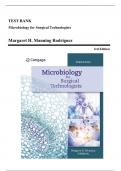Exam (elaborations)
Test Bank - Microbiology for Surgical Technologists, 3rd Edition (Rodriguez, 2023), Chapter 1-22 | All Chapters
- Course
- Institution
- Book
Test Bank - Microbiology for Surgical Technologists, 3rd Edition (Rodriguez, 2023), Chapter 1-22 | All Chapters
[Show more]




